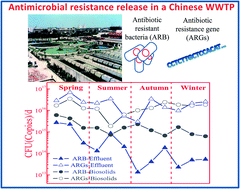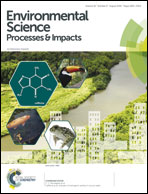Monitoring and assessing the impact of wastewater treatment on release of both antibiotic-resistant bacteria and their typical genes in a Chinese municipal wastewater treatment plant†
Abstract
Wastewater treatment plants (WWTPs) are important hotspots for the spread of antibiotic resistance. However, the release and impact factors of both antibiotic resistant bacteria and the relevant genes over long periods in WWTPs have rarely been investigated. In this study, the fate of bacteria and genes resistant to six commonly used antibiotics was assessed over a whole year. In WWTP effluent and biosolids, a high prevalence of heterotrophic bacteria resistant to vancomycin, cephalexin, sulfadiazine and erythromycin were detected, each with a proportion of over 30%. The corresponding genes (vanA, ampC, sulI and ereA) were all detected in proportions of (2.2 ± 0.8) × 10−10, (6.2 ± 3.2) × 10−9, (1.2 ± 0.8) × 10−7 and (7.6 ± 4.8) × 10−8, respectively, in the effluent. The sampling season imposed considerable influence on the release of all ARB. High release loads of most ARB were detected in the spring, while low release loads were generally found in the winter. In comparison, the ARG loads changed only slightly over various seasons. No statistical relevance was found between all ARB abundances and their corresponding genes over the long-term investigation period. This inconsistent behavior indicates that bacteria and genes should both be considered when exploring resistance characteristics in wastewater. A redundancy analysis was adopted to assess the impact of wastewater quality and operational conditions on antibiotic resistance. The results indicated that most ARB and ARG proportions were positively related to the COD and turbidity of the raw sewage, while negatively related to those of the effluent. DO and temperature exhibited strong negative relevance to most ARB prevalence.


 Please wait while we load your content...
Please wait while we load your content...